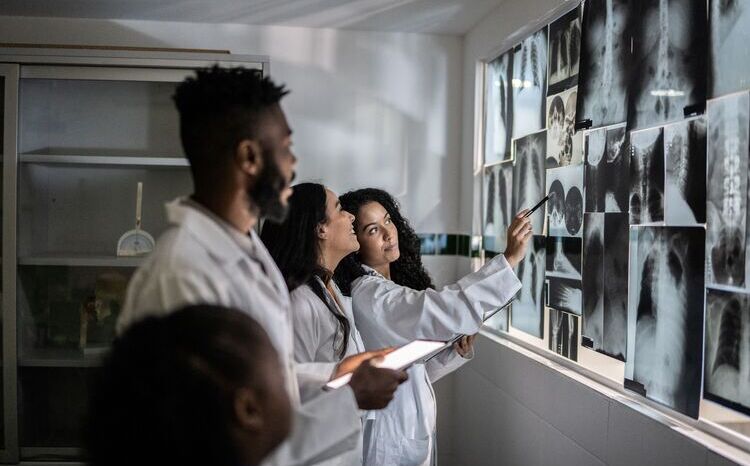CCIO profile: Shona Campbell
- 17 April 2013

University Hospitals of Leicester NHS Trust is demonstrating something of an idiosyncratic streak when it comes to informatics.
For a start, it has adopted the American rather than the British vernacular to describe its clinical leaders in this field – it has chief medical information officers rather than chief clinical information officers.
But that plural is intentional. Unusually, the trust has appointed not one but two individuals to provide leadership in this sphere.
“The advert was for one person, but when they interviewed they appointed two of us,” explains Dr Shona Campbell, consultant radiologist, director of the trust’s clinical support division, and one of those two CMIOs.
“Thankfully we both get on really well and we’re bouncing ideas off each other already.”
Two pairs of legs, two heads
Dr Campbell believes that having two clinical leaders in information will offer real benefits.
For a start, the trust is one of the country’s largest – 10,000 staff working over three sites – “so getting around everybody and making sure they know what we’re about is going to be a fair amount of time in itself.”
In other words, two pairs of legs are better than one. But it is also a case of two heads being better than one, especially when they bring different perspectives to the challenge of clinical informatics.
“My fellow CMIO Steve [Jackson] is a consultant in diabetes and endocrinology, so his viewpoint is much more ward-, outpatient-based, and he doesn’t have a managerial background,” explains Dr Campbell.
“So we’re coming at it from two different aspects, which is actually really interesting because I think we both bring particular perspectives to the role.”
For a radiology consultant, those perspectives are a deep understanding of how technology has and can change healthcare.
“My working life has changed completely since I started practising way back when. Back when, we had packets of films and films had to be stuck up onto viewing boxes,” Dr Campbell says.
“Suddenly, picture archiving and communications systems came along and completely changed the way we work as radiologists.
"But it could change even more – we can now report images from wherever; I could sit at home and report from there if I wanted to.”
IT’s about improving processes
Asked to pinpoint when she first became interested in clinical informatics, Dr Campbell says she is unsure.
She describes instead a “growing realisation that really we don’t use technology enough and in the right way” but, importantly, an interest in process improvement.
“One of my light bulb moments was reading Deming’s tome ‘Out of the Crisis’ [first published in 1982, the book offers 14 points of good management, all of which tie tightly to the ideas of Lean methodology and process improvement].
"I thought: oh my goodness, this is what’s wrong with healthcare in acute hospitals.
“It’s really about the people. The technology, I think, is almost a slight distraction because people get hung up on new toys. Whereas actually what you need to change is processes and systems.”
Dr Campbell argues it is especially important that any change is through the whole system rather than centred on one small part of it. It is a belief centred on her own experience of practice.
“Radiologists are forever being told: ‘oh, if only you did this quicker’. But, actually, we find that when we do it quicker, nothing happens as a result!
“You’ve worked hard trying to get a patient scanned quickly, and then discover that nobody’s actually paid any attention or done anything with the report.
“It’s incredibly frustrating, because the data’s all there. It’s just that for some reason we’re really bad in hospitals at bringing it together.”
Taking to new IT
It is a problem that University Hospitals of Leicester is aiming to address through the introduction of a full electronic patient record.
The system is being procured and implemented in partnership with IBM, with the IT giant also helping to address a number of related issues first – the creation of a clinical portal system, the rollout of e-prescribing, and the introduction of full electronic requesting for tests among them.
“We’ve been lagging behind a bit in our reliance on paper,” admits Dr Campbell. “Folks carry about their iPads and think: well, why can’t I see patient records on here?
“We’ve just introduced iPhones into the emergency department as a method of communication between doctors and it’s interesting that people have just taken to them.
“It’s part of the transformation process in the department to improve patient flow. People are using them for things like electronic dictation, and using that for looking after clinical issues.
"We’re watching how technology can enable some very simple things in terms of communication and flow.”
There are a number of clinicians in the trust showing interest in such improvements.
The organisation’s IT strategy group already has what Dr Campbell characterises as “good clinical involvement”. For her, the aim now is to involve other types of clinicians.
“I’d quite a little bit more non-doctor involvement,” she explains. “As director for clinical support I’ve been managing and leading people like physiotherapists, occupational therapists, pharmacists, theatre practitioners, clinical scientists for the past three years, so I know they are extremely capable people.
“But they often get forgotten about in the hospital environment, where we always think of doctors and nurses. So I’d quite like to open up the IT strategy group to make it a bit more cross-sectional of the hospital.”
Mouthwatering challenges
She anticipates that this and the other clinical informatics work will take up a significant chunk of her time.
While the job description is for a minimum of four planned activities (PAs) overall, Dr Campbell – who officially took up her role on 1 March – is expecting to spend three days a week on her CMIO role, at least at first.
“There is so much to do, and that’s part of what makes this role really exciting – daunting too!” she says.
But she’s enthusiastic about the challenge. “The capacity for improvement and making everybody’s lives a bit better and easier is really quite mouthwatering.”




